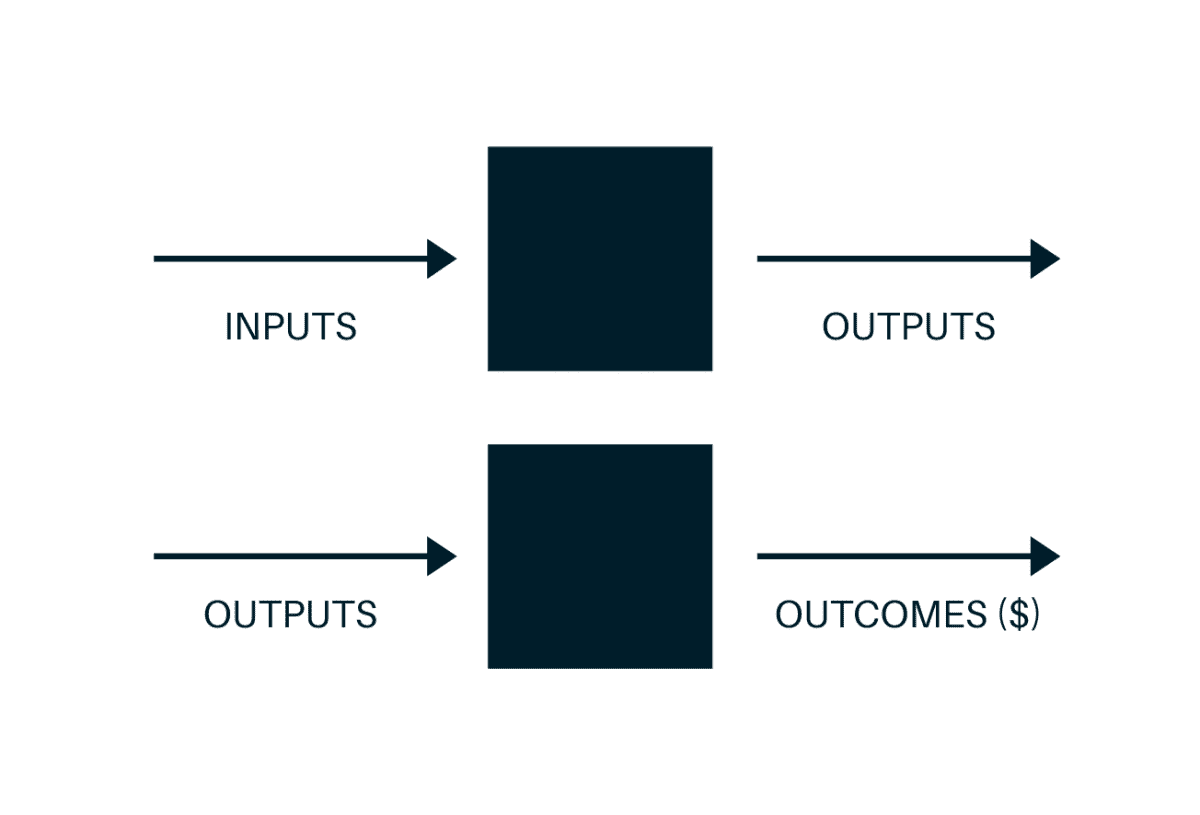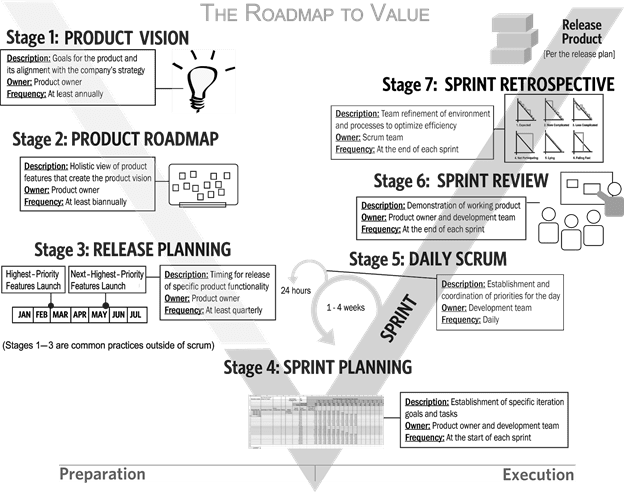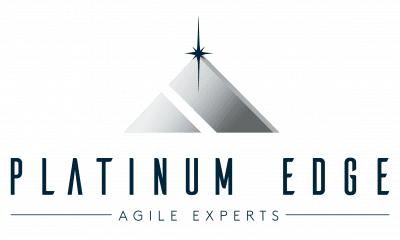Understanding the difference between outputs vs. outcomes is critical for high-performing scrum teams. Outputs are the amount of something produced by a person or team. Outcomes are the value or the end benefit, a consequence. Scrum teams use empirical process controls on both outputs and outcomes. Both undergo inspection to allow the team to adapt; the more transparent, the better.
Outputs can be, for example, features developed or functionality produced. Outcomes are the targets or the results you want to accomplish from those outputs, like increased quality or higher customer satisfaction. Outcomes are the value the teams create from their sprint (output) to satisfy the stakeholder and customer needs (outcomes). Product owners decide to release when enough value creation occurs to achieve the desired outcomes for their users.

We’ll discuss the difference between outputs vs. outcomes and how agile teams use both. We’ll also look at how organizations can become more outcome-focused in delivering results.
Examples of outputs and outcomes
Some common examples of each that may be helpful for starters are:
Outputs:
- Hours worked
- Lines of code
- Team velocity
- A product increment
- A burndown chart
- A completed sprint ceremony
- An automated test case
- A refined product backlog or sprint backlog
- Stakeholder feedback
- A retrospective experiment
- Within scope, budget, and on-time delivery
Outcomes:
- Improved team velocity
- A validated hypothesis
- Decreased internal cost
- Increased monthly subscriptions
- Improved customer retention
- Increased patient lives saved
- Increased stock price
- Increased market share
Scrum teams create outputs
Scrum teams continuously evaluate the outputs they create. They use them as indicators for identifying opportunities to adapt. Agile tools such as sprint backlogs, task boards, burndown charts, and velocity trends exist to help them evaluate delivery. Ceremonies such as sprint planning, daily scrum, sprint reviews, and sprint retrospectives help teams maximize outputs. They pay attention to the intended and unintended outputs of their teamwork.
Focusing on outputs alone, however, can lead to trouble. The outputs of a team must achieve the outcomes demanded by their customers. Agile product development is about iteratively experimenting with tight, short feedback cycles until you reach the desired outcomes for stakeholders and customers. The team iteratively replaces uncertainty with certainty.
Not all outputs translate to outcomes. Hours worked and lines of code written, for example, do not necessarily mean a higher outcome for the customer. In some cases, focusing on the wrong outputs may decrease customer outcomes.
Agile principles guide teams in creating and improving outputs
- Businesspeople and developers must work together daily throughout the project.
- Building projects around motivated individuals. Give them the environment and support they need. Then trust them to get the job done.
- The most efficient and effective method of conveying information to and within a development team is face-to-face conversation.
- Agile processes promote sustainable development. The sponsors, developers, and users should be able to maintain a constant pace indefinitely.
- Continuous attention to technical excellence and good design enhances agility.
- Simplicity—the art of maximizing the amount of work not done—is essential.
- The best architectures, requirements, and designs emerge from self-organizing teams.
- At regular intervals, the team reflects on how to become more effective, then tunes and adjusts behavior accordingly.
Scrum teams achieve outcomes
The foundational element for achieving outcomes is the long-lived, nearly permanent scrum team itself. Scrum teams consist of a product owner who understands the customer and can set a vision for their needs, a cross-functional, multi-skilled development team, and a servant-leader scrum master.
As they work together, they’ll navigate Tuckman’s four phases of forming, storming, norming, and performing. They’ll intimately understand the product and enhance the architecture sprint after sprint, aligning their product to meet users’ needs better (known as “emergent architecture”). Through the process, they’ll develop a profound understanding of the customer. To break up or disrupt the team sets the entire organization back in their quest for outcome-based-delivery. With their shared memory about the customer and product, the enduring scrum team can perfectly deliver better results and outcomes.
The outputs they’ll produce will be many and may even increase with time, as they become more proficient in applying their retrospective experiments. But the outcomes they’ll create will become the focus of every ceremony, artifact, and role. The sprint review is the feedback sounding board for evaluating actual or anticipated outcomes. Organizational support and empowerment will improve their ability to deliver outcomes.
Agile principles that help them achieve outcomes are:
- Our highest priority is to satisfy the customer through early and continuous delivery of valuable software.
- Welcome changing requirements, even late in development. Agile processes harness change for the customer’s competitive advantage.
- Deliver working software (product) frequently, from a couple of weeks to a couple of months, with a preference to the shorter timescale.
- Working software (product) is the primary measure of progress.
How do organizations get on the path to delivering outcomes?
The roadmap to value is the foundation for achieving desired outcomes. It starts in the upper left with a clear product vision outlining the target customer, the benefits they’ll gain, and the product’s differentiators from competing alternatives. It gives the user a compelling reason to “buy” their product (if it were for sale).
This, followed with a roadmap of product features describing outcomes the user will receive, creates an unstoppable product strategy from the beginning. With each feature, the team builds the roadmap using the phrase, “My customer can now…” It systematically narrows in on the desired outcomes with each feature, epic, and user story.

While not technically part of the definition of scrum, user stories are excellent tools for focusing on outcomes. In fact, the purpose of acceptance criteria is to capture the feature’s desired outcome. All development and testing become focused on validating that they’ve achieved the desired outcomes. The team’s definition of Done ensures that the functionality is usable for achieving those outcomes.
With the product vision and roadmap in place, the boundaries for planning releases and sprints and establishing goals and even stories to achieve outcomes are clear. The product vision, each epic and feature, each goal, each user story, and even each task are traceable back to and supportive of the desired outcomes.
The purpose of an agile transformation is to help the organization deliver better outcomes. Agile transformation is a topic of much research and discussion. Here are the keys:
- Begin with an agile assessment: Understand where you are so you can define a path forward.
- Prepare for your journey: Train, communicate, and build organizational support and momentum for change.
- Lead by example in practicing agile values and principles: Let your example of outcome-based delivery be why people will follow.
- Get help: Partner with an experienced transformation guide (like our coaching staff at Platinum Edge).
Outcomes create meaningful value
High-performing, enduring scrum teams are obsessed with achieving outcomes for their customers. While outputs are essential, and the teams frequently inspect and adapt based on outputs, it’s the outcomes that create meaningful value.
These scrum teams let every story, task, sprint, release, product roadmap, and vision lead to outcomes. They let every daily scrum, sprint planning, backlog refinement, sprint review, and retrospective end in outcomes. They maximize empirical process controls by evaluating the outputs and outcomes along the way using inspection, adaptation, and transparency.
Customers will not pay you for your outputs. They’ll pay you for how well your product meets their needs or solves their problems. They’ll pay you for the value you create—for the outcomes you achieve for them.
We’re outcome-focused at Platinum Edge. We have an output of training over 12,000 students. Our students have an outcome of 99.99% recommendation rate, one of the highest in the industry.
Learn more about how we can drive meaningful value for your organization.


